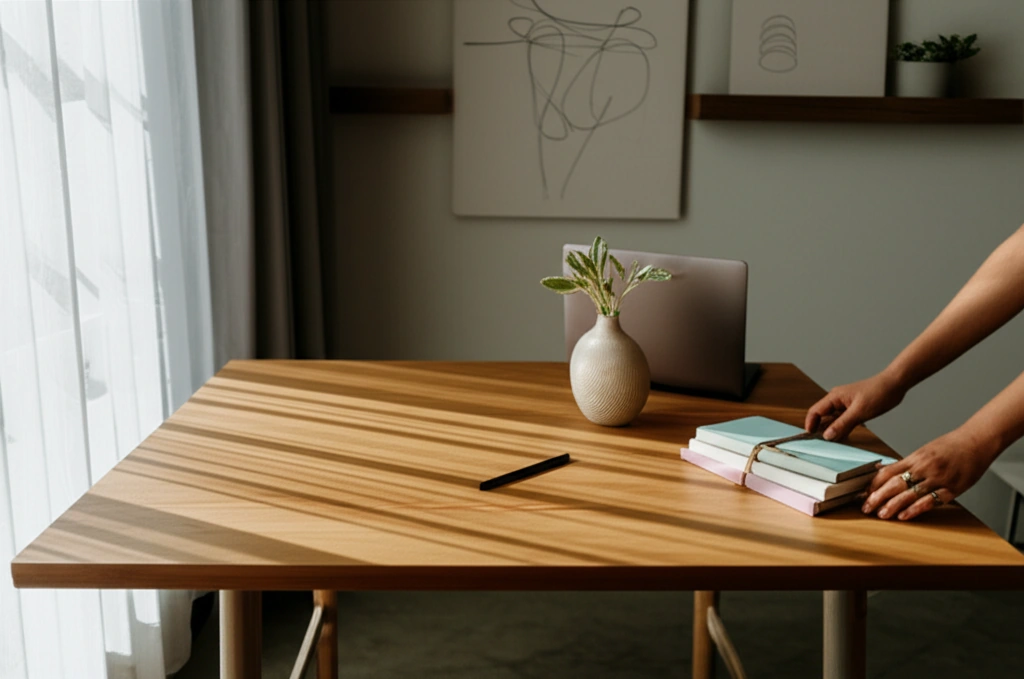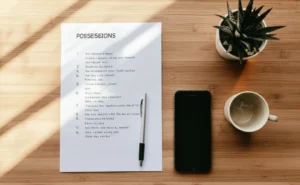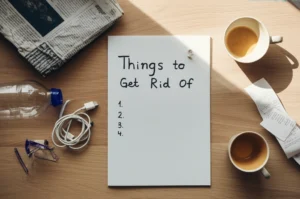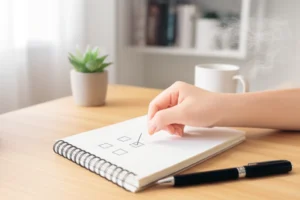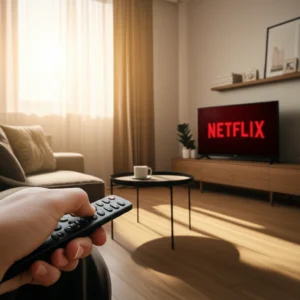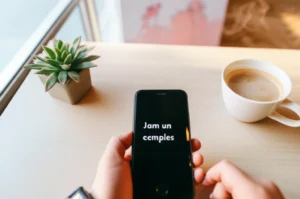Have you ever stared at a messy corner and felt like your whole brain cluttered up with it? Yeah, me too. But here’s the thing: decluttering isn’t just throwing stuff away—it’s about creating breathing room for your life, your thoughts, your peace. If you’re hunting for some easy, heartfelt declutter minimalism tips, you’re in the right place. Let’s cut through the overwhelm and get to the good stuff, so your home feels less like a storage unit and more like a sanctuary.
Why bother? Because living with less stuff can actually clear your mental fog and make day-to-day life flow smoother. Plus, I’ll be honest—with tight spaces or busy lives, having a clutter-free vibe isn’t just nice, it’s life-changing. Together, we’ll explore not only smart strategies but also the psychological perks and a few things to watch out for, just so you don’t get stuck in the “less is more” trap.
Decluttering Mindset
Decluttering Versus Minimalism — What’s The Difference?
Let’s clear this up quickly. Decluttering means removing the things you don’t need or love anymore — a sort of cleanup. Minimalism goes a step further. It’s about questioning what you actually need and making choices to keep only what truly serves your purpose.
So, decluttering might be clearing out that junk drawer, while minimalism asks, “Do I even need a junk drawer?” Both are powerful, but minimalism challenges you to rethink your relationship with stuff, rather than just tidy it up.
Who Can Benefit From These Tips?
Honestly, anyone! But if you live in a small apartment, juggle a busy schedule, or want to live more intentionally, this will resonate even more. Sometimes, the tightest spaces beg for smart solutions, and that’s where these declutter minimalism tips really shine.
Quick-Start Checklist
The “One-Zone” Rule
Ever felt paralyzed looking at your whole room and not knowing where to start? Here’s a secret — start small. Pick just one surface, drawer, or shelf. Clear it out completely. Then sort everything using four piles: Keep, Donate, Trash, Relocate.
Keep only what you truly use or love. Be honest: if it hasn’t sparked joy — or usefulness — in a while, it’s probably time to say farewell. This method saves your sanity and gives a quick win that feels amazing.
Easy Decision Rules To Follow
Try this on for size:
- If you’ve used it in the last 30 days, keep it.
- If it’s broken beyond repair, toss it.
- Sentimental stuff? Snap a photo and thank it goodbye.
These little decision shortcuts keep the process moving without second-guessing everything. If you want a handy tool, check out this minimalist decluttering checklist to keep you on track.
Decluttering Methods That Work
Popular Methods To Know
| Method | How It Works | Best For |
|---|---|---|
| KonMari | Tidy by category, keep only what “sparks joy” | Those who want emotional connection with possessions |
| Four-Box Method | Label boxes: Keep, Donate, Trash, Relocate | Practical, straightforward decluttering of any space |
| Ski-Slope Method | Work room corner to corner, focusing on one zone | People who want manageable, less overwhelming steps |
| One-In, One-Out Rule | When you buy one item, remove one | Maintenance to keep clutter from creeping back |
Choosing What Fits Your Life
Not every method fits all. You might love KonMari’s spark-joy philosophy but find it tricky with sentimental items. Or maybe the Four-Box Method’s simplicity gives you the momentum to finish. The key is to find what keeps you motivated without stress.
Psychology Behind Decluttering
Why Does Minimalism Feel So Good?
Science and experience show that clutter leads to anxiety and decision fatigue — your brain is working overtime. Fewer possessions mean less visual noise, fewer choices, and a calmer environment.
There are real psychological benefits of minimalism like lowered cortisol (stress hormone) levels and improved focus. Imagine walking into your home feeling peaceful, not overwhelmed.
The Not-So-Great Sides
But hey, no fairy tale here. Minimalism isn’t perfect — some people feel they lose emotional connection with things or get caught up in striving for an impossible ideal. Sometimes, it can even cause social friction (“Why do you have so little?”) or rebound shopping binges to fill a void.
Accepting these disadvantages of minimalism helps you adapt healthily. Balance is the secret — minimalism should serve you, not stress you out.
Room-by-Room Decluttering
Living and Multipurpose Areas
Your living space is where you spend most energy, so it should feel welcoming and uncluttered. Keep furniture functional—think hidden storage chairs or slimline shelves. Limit visible stuff on surfaces to daily essentials. It can make a small studio feel BIGGER.
Kitchen Counters
This is often the clutter hotspot. Keep counters clear with just the basics you use daily. Maybe a coffee maker and a few utensils. The rest? Store them smartly out of sight.
Closet and Clothes
Love clothes but hate the clutter? Seasonal rotation helps (keep only current season within easy reach). Donate pieces you haven’t worn in a year. When in doubt, could these items fit into a capsule wardrobe? Remember, fewer choices equals less time spent deciding what to wear.
Bathroom & Toiletries
Limit toiletries to your daily routine essentials. Extras like products you never touch can be donated or recycled. A minimalist grooming kit simplifies your space and your routine.
Papers & Digital Clutter
Paper shadows your space long after you deal with them. Try a 30-day inbox rule: Act on mail asap; file or shred what you don’t need. Digitally, unsubscribe from cluttering newsletters to keep your mind tidy, too.
Keeping It That Way
Daily Micro-Habits
Spend 5–10 minutes tidying up one small area daily. Little sparks fire big fires—the one-shelf-rule can stop clutter piles from scaling your home.
Monthly Checks
Once a month, do a quick audit with a camera. Snap a before-and-after photo to see your progress and remind yourself why you’re doing this.
Habits To Maintain Minimalism
The “one in, one out” rule is a gentle guardrail to stop clutter from sneaking back in. Set reminders or calendar blocks to review your space regularly.
Tools And Resources
Checklists & Apps
It’s easier to stick with a plan when you have a roadmap. Peek at this minimalist decluttering checklist to get some structure. Apps with timers and donation scheduling features can gamify and streamline your progress.
Pro Help
If you’re feeling stuck, professional organizers can provide tailored support, motivation, and resources. Costs vary but can be a worthy investment. Just remember to ask about their approach to minimalism to make sure you vibe.
Real-Life Stories
Let me tell you about a pro declutterer who transformed her studio apartment — a space no bigger than some people’s bedrooms. She started simply: one junk drawer cleared, then a shelf, then the whole living area. The result? A cozy, tidy space that felt twice as big with half the stress. That process might feel daunting, but it’s all about baby steps and purpose.
What about you? Ever had that “aha” moment after a little tidy? I’ve had dozens, and it’s that spark that gets me moving again when clutter creeps back. Remember: your story counts too.
Common Mistakes To Avoid
Decluttering As Punishment
It’s tempting to think you “should” declutter because of guilt or to fix your life overnight. But slow and steady wins. Set manageable goals and celebrate small wins — they build momentum and joy.
Never Donate Piles
That box for “donate later”? It can become clutter itself. Schedule a pickup or drop-off quickly — within a week, ideally — to keep your space clear.
Over-Restricting Rules
Minimalism isn’t a cage. If a strict rule feels suffocating, tweak it. Flexible minimalism means your system grows with you instead of fighting against you.
Ethical And Sustainable Decluttering
Getting rid of stuff doesn’t mean throwing it in the trash. Consider donating to local charities, reselling online, or recycling responsibly. Minimalism often aligns with frugal living — spending less, caring more — which benefits your wallet and the planet.
Being thoughtful about where your items go helps you feel better about letting go and supports a more sustainable lifestyle.
Final Thoughts
So, here’s the heart of it: these declutter minimalism tips aren’t about a perfect space or owning nothing. They’re about clearing enough room — in your home, and your head — to live better, feel peaceful, and focus on what truly matters.
Start with a small zone, set simple rules, pick a method that fits your vibe, and embrace the psychological boost of fewer distractions. But remember, minimalism is your friend, not a tyrant — balance the benefits with awareness of potential downsides.
Feel like jumping in? Grab that drawer, set a timer for 20 minutes, sort with the four-box method, and schedule a donation pickup. The feeling when it’s done? Unbeatable. And if you want some extra guidance, the minimalist decluttering checklist is a great companion.
What’s your next decluttering step? Whatever it is, keep going—you’re creating more space for joy, clarity, and life itself.

